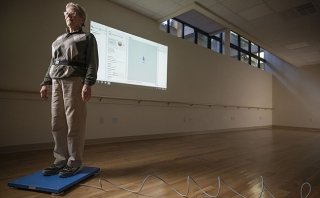Study Seeks to Explain Decline in Hip Fracture Rates
Report suggests lifestyle choices play an important role in hip fracture prevention.
-

Senior Scientist
-

Senior Scientist
BOSTON – In a paper published in the Journal of the American Medical Association Internal Medicine today, researchers showed how analysis of data from the multigenerational Framingham Osteoporosis Study may in part explain why the incidence of hip fracture in the U.S. has declined during the last two decades. Douglas P. Kiel, M.D., M.P.H., and Marian T. Hannan, D.Sc., M.P.H., are among the authors. Dr. Kiel is Director, and Dr. Hannan is Co-Director, of the Musculoskeletal Research Center in the Hinda and Arthur Marcus Institute for Aging Research at Hebrew SeniorLife.
Led by Dr. Kiel, the Framingham Osteoporosis Study is an ancillary study of the Framingham Heart Study, which enrolled its first cohort of participants in 1948 and now includes a third generation of participants. Initially launched to understand the epidemiology of cardiovascular disease, the study has become a treasure trove of data for epidemiologists searching for factors that contribute to many conditions that impact public health, including hip fractures. An estimated 150,000 hip fractures occur each year in the U.S., with estimated costs of care between $10.3 billion and $15.2 billion.
The cause of the decrease in the incidence of hip fracture is unknown, but has been attributed to the treatment of osteoporosis – a disease that causes bones to become weak and brittle. However, in this study, researchers looked at factors beyond osteoporosis treatment that could better explain the dramatic decline in hip fracture in recent decades. For example, Framingham Osteoporosis Study data showed that in persons aged 85 to 89 years, the incidence of hip fracture was 759 per 100,000 person-years in the offspring group compared with 2,018 per 100,000 person-years in the original cohort. The decrease in fracture was too significant to be explained by osteoporosis treatment alone, especially since the decreases were occurring before the availability of effective treatments for osteoporosis.
Study researchers carefully looked at decades of hip fracture data, which allowed statistical differentiation of changes in the incidence of hip fractures arising from the year of birth, aging, and the time period in which the data was collected. They found that a reduction in smoking and excessive alcohol consumption explained some of the declines in rates, emphasizing that ongoing public health considerations help to prevent fractures.
As a result of this study, Dr. Kiel cautioned, “While there is still a need to treat patients with osteoporosis, health care providers should continue to encourage public health interventions, specifically smoking cessation and preventing heavy drinking of alcohol.”
Dr. Hannan added, “There is a need to continue public health approaches along with treating osteoporosis to decrease fracture risk.”
This study was funded by the National Institute of Health’s National Institute of Arthritis and Musculoskeletal and Skin Diseases.
About the Hinda and Arthur Marcus Institute for Aging Research
Scientists at the Hinda and Arthur Marcus Institute seek to transform the human experience of aging by conducting research that will ensure a life of health, dignity, and productivity into advanced age. The Marcus Institute carries out rigorous studies that discover the mechanisms of age-related disease and disability; lead to the prevention, treatment, and cure of disease; advance the standard of care for older people; and inform public decision-making.
About Hebrew SeniorLife
Hebrew SeniorLife, an affiliate of Harvard Medical School, was founded in 1903 and today is a national leader dedicated to empowering seniors to live their best lives. Hebrew SeniorLife cares for more than 3,000 seniors a day across six campuses throughout Greater Boston. Locations include: Hebrew Rehabilitation Center-Boston and Hebrew Rehabilitation Center-NewBridge in Dedham; NewBridge on the Charles, Dedham; Orchard Cove, Canton; Simon C. Fireman Community, Randolph; Center Communities of Brookline; and Jack Satter House, Revere. Hebrew SeniorLife also trains more than 1,000 future health care professionals each year, and conducts influential research into aging at the Hinda and Arthur Marcus Institute for Aging Research, which has a robust research portfolio whose NIH funding in 2021 places it in the top 10% of NIH-funded institutions. For more information about Hebrew SeniorLife, visit our website or follow us on our blog, Facebook, Instagram, Twitter, and LinkedIn.



